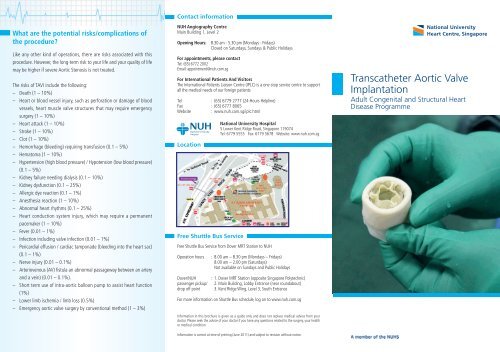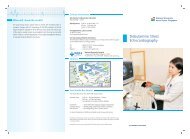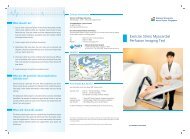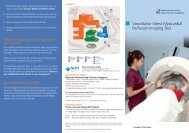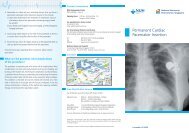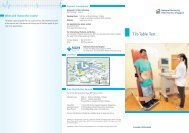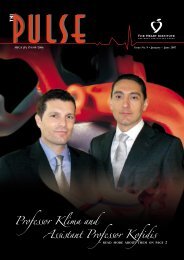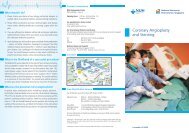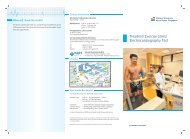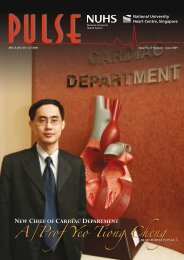Transcatheter Aortic Valve Implantation - nuhcs
Transcatheter Aortic Valve Implantation - nuhcs
Transcatheter Aortic Valve Implantation - nuhcs
You also want an ePaper? Increase the reach of your titles
YUMPU automatically turns print PDFs into web optimized ePapers that Google loves.
What are the potential risks/complications ofthe procedure?Like any other kind of operations, there are risks associated with thisprocedure. However, the long-term risk to your life and your quality of lifemay be higher if severe <strong>Aortic</strong> Stenosis is not treated.The risks of TAVI include the following:– Death (1 – 10%)– Heart or blood vessel injury, such as perforation or damage of bloodvessels, heart muscle valve structures that may require emergencysurgery (1 – 10%)– Heart attack (1 – 10%)– Stroke (1 – 10%)– Clot (1 – 10%)– Hemorrhage (bleeding) requiring transfusion (0.1 – 5%)– Hematoma (1 – 10%)– Hypertension (high blood pressure) / Hypotension (low blood pressure)(0.1 – 5%)– Kidney failure needing dialysis (0.1 – 10%)– Kidney dysfunction (0.1 – 25%)– Allergic dye reaction (0.1 – 1%)– Anesthesia reaction (1 – 10%)– Abnormal heart rhythms (0.1 – 25%)– Heart conduction system injury, which may require a permanentpacemaker (1 – 10%)– Fever (0.01 – 1%)– Infection including valve infection (0.01 – 1%)– Pericardial effusion / cardiac tamponade (bleeding into the heart sac)(0.1 – 1%)– Nerve injury (0.01 – 0.1%)– Arteriovenous (AV) fistula an abnormal passageway between an arteryand a vein) (0.01 – 0.1%).– Short term use of intra-aortic balloon pump to assist heart function(1%)– Lower limb ischemia / limb loss (0.5%)– Emergency aortic valve surgery by conventional method (1 – 3%)Contact informationNUH Angiography CentreMain Building 1, Level 2Opening Hours: 8.30 am - 5.30 pm (Mondays - Fridays)Closed on Saturdays, Sundays & Public HolidaysFor appointments, please contactTel: (65) 6772 2002Email: appointment@nuh.com.sgFor International Patients And VisitorsThe International Patients Liaison Centre (IPLC) is a one-stop service centre to supportall the medical needs of our foreign patientsTel: (65) 6779 2777 (24-Hours Helpline)Fax : (65) 6777 8065Website : www.nuh.com.sg/iplc.htmlLocationFree Shuttle Bus ServiceFree Shuttle Bus Service from Dover MRT Station to NUHOperation hoursNational University Hospital5 Lower Kent Ridge Road, Singapore 119074Tel: 6779 5555 Fax: 6779 5678 Website: www.nuh.com.sg: 8.00 am – 8.30 pm (Mondays – Fridays)8.00 am – 2.00 pm (Saturdays)Not available on Sundays and Public HolidaysDover/NUH : 1. Dover MRT Station (opposite Singapore Polytechnic)passenger pickup/ 2. Main Building, Lobby Entrance (near roundabout)drop off point 3. Kent Ridge Wing, Level 3, South EntranceFor more information on Shuttle Bus schedule, log on to www.nuh.com.sgInformation in this brochure is given as a guide only and does not replace medical advice from yourdoctor. Please seek the advice of your doctor if you have any questions related to the surgery, your healthor medical condition.Information is correct at time of printing (June 2011) and subject to revision without notice.<strong>Transcatheter</strong> <strong>Aortic</strong> <strong>Valve</strong><strong>Implantation</strong>Adult Congenital and Structural HeartDisease Programme
Why is <strong>Transcatheter</strong> <strong>Aortic</strong> <strong>Valve</strong><strong>Implantation</strong> (TAVI) needed?<strong>Transcatheter</strong> <strong>Aortic</strong> <strong>Valve</strong> <strong>Implantation</strong> (TAVI) is used to treat severe <strong>Aortic</strong>Stenosis, a condition in which the aortic valve becomes narrowed, obstructingthe outflow of blood from the heart and thereby requiring the heart to workharder to pump blood around the body.TAVI is a procedure performed using the Edwards Sapien <strong>Transcatheter</strong>Heart <strong>Valve</strong> (THV), an artificial heart valve designed to be inserted into yourheart so that it holds open and replaces your diseased aortic valve. It consistsof a metal stent (made of steel or cobalt-chromium) which secures thedevice in its intended position inside your own valve, and valve leaflets(made of biological material derived from cows) to direct the flow of bloodout of your heart.TAVI now offers effective treatment to patients who are at high risk forconventional open heart surgery. It is also intended to prevent furtherdamage to the heart from <strong>Aortic</strong> Stenosis and to prolong life, which medicaltherapy cannot do.Normal <strong>Aortic</strong> <strong>Valve</strong>Normal <strong>Aortic</strong> StenosisOpen Closed Open ClosedWhat can I expect before the procedure?Before the procedure, you will undergo routine investigations to evaluatewhether TAVI is possible and which of the two techniques for TAVI(Transfemoral or Transapical route) is most appropriate for you. Theinvestigations will also and to identify any other considerations that needto be addressed for your treatment. The investigations include:– A physical examination– Angiogram– Blood tests– Chest X-ray– CT Scans– ElectrocardiogramWhether you are selected to undergo the transfemoral or the transapicalapproach, this procedure will be performed under general anesthesia. Asthe heart is not opened to expose the aortic valve, fluoroscopy (X-rays) andtransesophageal echocardiography (ultrasound) are used to visualize theheart and THV, and to guide the insertion of the THV. The duration of X-rayexposure that you will receive will normally be not more than 30 minutes,the normal length of time it takes for a coronary artery procedure in thecardiac catheterization laboratory.Transfemoral TAVIThe transfemoral device is designed to be implanted through the bloodvessel (femoral artery) in your leg. Due to the size of the catheter (hollowtube) being placed in your artery for this approach, your doctors will evaluatethe angiograms and/or CT scans to ensure your blood vessels are big enoughfor this device. Prior to implantation, the THV is “crimped” (carefullycompressed to a size that fits inside your femoral artery) using a specificallydesigned crimping device. The crimped THV is mounted onto a balloondelivery catheter, a special device which is used to carry the THV up to theheart and directly into your aortic valve. The valve is then expanded usinga balloon to fit inside your stenotic aortic valve, holding your own valveopen permanently. Once the valve is in position and the delivery system isremoved from your femoral artery, the artery is closed using a special suturedevice designed for this purpose. After the procedure, you will be transferredto the Coronary Care Unit (CCU).Transapical TAVIThe transapical approach is used for patients whose arteries are too smallor too diseased for the transfemoral approach.Figure 1: Balloon inflation of the<strong>Transcatheter</strong> <strong>Valve</strong>Figure 2: Final result.The delivery system for this approach is designed for THV implantationthrough the tip (apex) of your heart, which is reached through a smallincision made between the ribs just below the left nipple. The crimpedTHV and delivery system is inserted through the apex of your heart directlyinto your stenotic aortic valve. The valve is then expanded using a balloonto fit across your stenotic aortic valve, holding it open permanently. Afterthe procedure you will be transferred to the Cardiothoracic Intensive CareUnit (CTICU).What happens after the procedure?After the TAVI procedure, you will be transferred to either the CCU wardor the CTICU ward for close monitoring. When you are first transferred,you may be under sedation and on ventilatory support. Over the courseof the next 24 hours, you will be awakened from the sedation and allowedto breathe on your own with the ventilation tube removed. You will remainin the CCU or CTICU ward until your doctor feels that you can be transferredto a regular hospital ward, where you will continue to be monitored untilyour discharge from the hospital, usually within 5 – 7 days.You will be given blood thinning medications such as aspirin and clopidogrel(Plavix). You should continue taking these or other blood thinners for 6months after the procedure and aspirin for life (as recommended forroutine stenting of coronary blood vessels and any replacement heartvalve). The following routine checks will be completed while you are inhospital:– A physical examination– Chest X-ray– Daily electrocardiogram (ECG)– Standard blood tests– Transthoracic echocardiogram (TTE)Thereafter, you will be required to see your doctor in the clinic after 30days, 6 months, 12 months, and then once a year. The routine checks suchas echocardiography are repeated at your first and subsequent outpatientfollow-ups.


